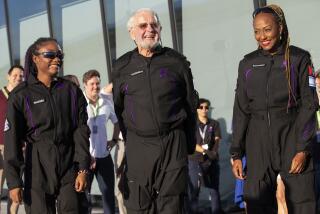Tourists Sitting on Top of the World
- Share via
For a little less than $8,000 you can fly from Canada to the North Pole, plunk down in a chair and truthfully say you are sitting on top of the world.
“It’s not a difficult trip at all and people just love it,” said Lydia Veristidi of Society Expeditions, a Seattle-based travel company that sends tourists on only the most exotic trips.
“The temperature averages anywhere between 35 below zero to zero, but we suit everyone up in caribou skins.”
Since Society Expeditions began trips to the North Pole four years ago, dozens of tourists have flown to it. Now several companies offer expeditions to the pole and travel agents say that interest in the Arctic in general and the North Pole in particular is picking up.
‘Total Adventure’
“We get people who have been everywhere else,” said Jerome Knap, owner of Canada North Outfitting, an Arctic tour group that has sponsored three expeditions to the pole in the last three years. “They want a total adventure, a feeling they’ve been somewhere that only a few have been.”
Although the pole is accessible by airplane, it is a logistically difficult trip, say travel agents who specialize in expeditions there. The North Pole is on a constantly moving ice cap that usually covers most of the Arctic Ocean. Five hundred miles from the nearest point of land, the pole can only be approached in the spring when the sun shines more than 20 hours a day and the temperatures are cold enough to keep the ice firm enough for a landing strip.
There is no marker at the pole. Pilots know they have reached it by monitoring navigational instruments, and travel agents admit that they sometimes miss the pinpoint.
“If we’re close enough, a mile or so, we’ll walk,” said Knap. “It’s difficult to pinpoint but we get awfully, awfully close.”
Small aircraft such as Twin Otters are used for the 500-mile trip from the northernmost airstrips of Canada. The planes must carry enough fuel not only to fly to the pole and back but to fly to another airstrip in case of an emergency.
“We fly ahead and leave caches of fuel along the route, then land and refuel a couple of times,” said Knap, whose company sponsors one pole trip a year with a maximum of 18 people. “Some groups fly a fuel plane alongside the passenger plane.”
No deaths or injuries have been reported on these pole expeditions, say travel agents, although one plane, forced to make an emergency landing on the ice, sank slowly through into the Arctic Ocean. The passengers left the plane safely and were picked up by another plane to continue their trip to the pole.
The travel groups outfit tourists in Arctic travel gear, either made of traditional caribou skins or modern fibers. The tourists may face temperatures as low as 40 or 50 degrees below zero during the hour or so they spend at the pole, sipping champagne and taking photographs.
Most of the expedition companies turn the pole trip into a weeklong Arctic adventure, adding seal and polar bear photo hunts, dog sled rides and visits to settlements of Inuit Indians, formerly called Eskimos.
‘Primitive and Rugged’
“The Arctic is primitive and rugged,” said Knap. “That’s why I’m pleased that we usually get more women than men on our pole trips. They are mostly professionals who are very widely traveled.
“The oldest has been 68 and most are in their 40s or 50s,” he said. “It takes a certain amount of income to make this trip.”
The trips, which usually include seven days in the Canadian Arctic, average between $7,500 and $8,000 per person. Society Expeditions is planning a journey for next spring.
Veristidi said traveling to the Arctic is not for everyone. “I personally like roughing it at a hotel on Maui,” she said.
For further information, contact a travel agent.
More to Read
Sign up for The Wild
We’ll help you find the best places to hike, bike and run, as well as the perfect silent spots for meditation and yoga.
You may occasionally receive promotional content from the Los Angeles Times.






